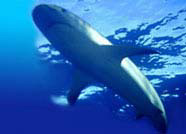


Evolution

 |
 |
 |
|||
| Home | Evolution
| Classification
| Glossary | Biology
| Behavior | Shark
Repellent | Shark
Conservation | Do's &
Don'ts | Did You Know?
Evolution |
 |
||||
|
|
||||||||||
|
Before jaws evolved, there was little for other fish
to swim fast for no other fish chasing them. With suction-type mouths,
biting prey was impossible. Fish probably scoured the bottom sucking up
whatever debris available. But with coming of fierce jaws, another food
resource became available-other fishes.
Tracing Shark history is as difficult as training Sharks. Unlike fishes, Sharks have cartilage instead of bones, and have "teeth", i.e. dermal denticles all over their body. Sharks have left very little traces of their existence, and only fossils available were of dermal denticles, spines, and occasional skeleton, under exceptional circumstances. The oldest shark-like creatures appeared in the fossil record towards the beginning of the Silurian period, about 450 million years ago, but the earliest known fossil teeth of true sharks do not appear until the Early Devonian, about 400 million years ago. Their teeth are small, no more than 4 mm (0.16 in) across, so their owner may have been no more than 30 cm (12 in) long. The skeleton of such a creature, a common ancestor for all the sharks and their relatives, has yet to be found. A candidate for close relative, however, is Antarctilamna, whose fossils have been found in rocks on the Antarctic continent. This fish was just 40 cm (16 in) long, and distinctly shark-like. It had a spine in front of a long dorsal fin, and teeth that had two large splayed cusps, with smaller cusps between them. To better understand their history, we can divide shark's evolution in 4 Eras, or Age:
|
|
|||||||||
| Sitemap | Reach To Us | Jimtrade - Business Directory of India | ||||||||||